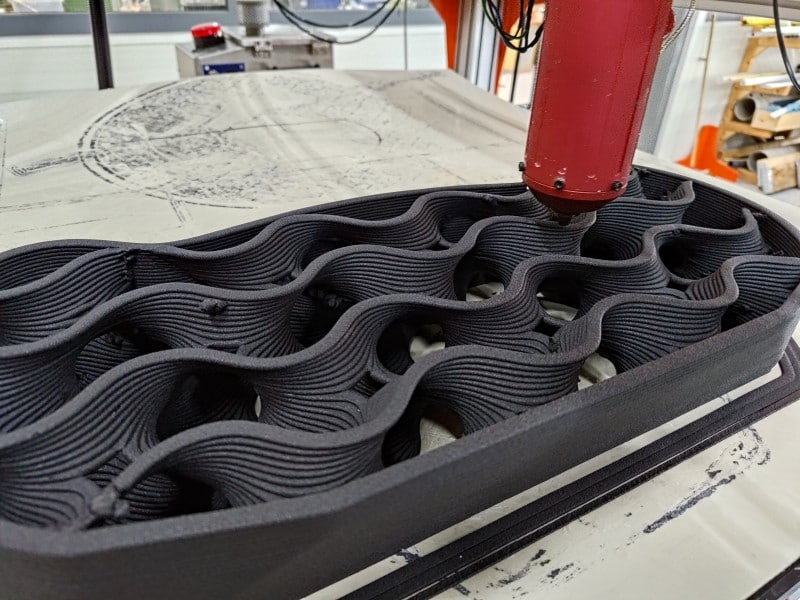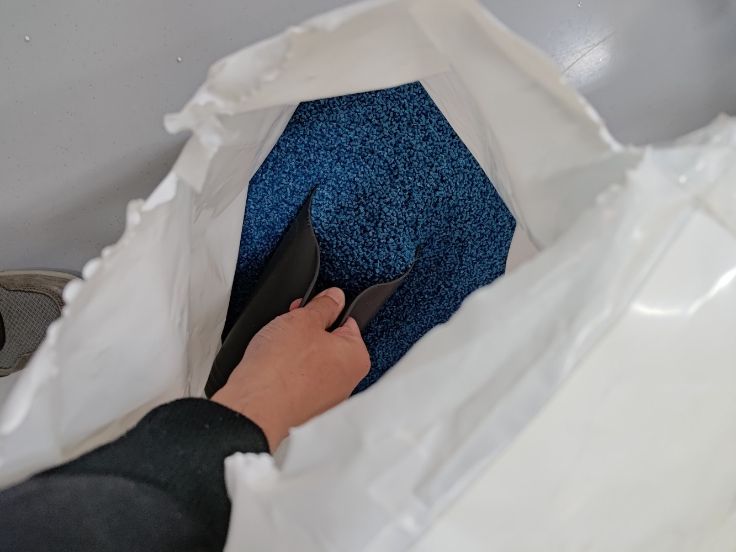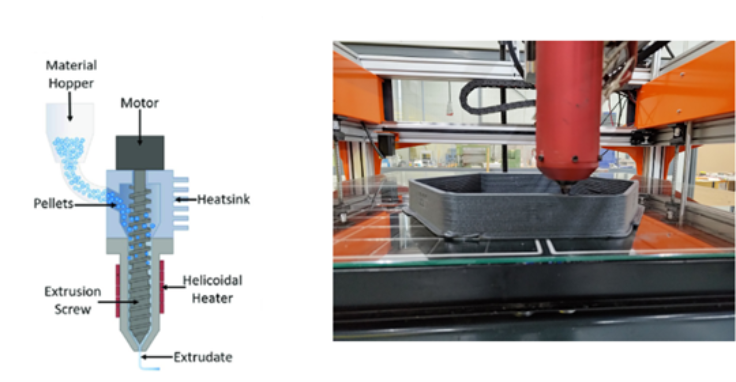
Redefining large scale 3D Printing with a wide range of materials
In the first article of this series, we introduced Fused Granulate Fabrication (FGF) and highlighted how it can enhance 3D printing with its unique value proposition. If you missed it, you can read the article here: Fused Granulate Fabrication (FGF): Unlocking the full potential of Additive Manufacturing
What is FGF?
Fused Granulate Fabrication is an extrusion-based additive manufacturing method that utilizes granular materials (pellets), typically plastics or composites, as the primary feedstock for printing. It uses a heated nozzle to melt and extrude the granules layer by layer, enabling the creation of intricate and customized objects. What sets FGF apart from other 3D printing methods is its versatility, as it can effectively utilize a wide range of commercially available plastic or composite granulates. This feature makes FGF a cost-effective and easily scalable option with numerous applications.

FGF is an emerging technology which stands out with its precise, high-speed plastics extrusion capability compared to fused filament fabrication (FFF). FGF's distinguishing feature lies in its versatility, as it accommodates a wide range of materials. However, this flexibility demands a more intricate printing process, necessitating custom process settings for different materials. This means that material processability requires a deeper technical understanding compared to Fused Filament Fabrication.
The printing process
A typical FGF 3DP process comprises a screw and barrel system, akin to those used in traditional extrusion and injection molding. Dry material in pellet form is loaded into a hopper, then conveyed to an extrusion screw. The screw's rotation propels the material through multiple heating zones, gradually heating and melting it (in the extruder) as it approaches the extrusion nozzle. As pressure builds up in the extruder, the material is extruded through the nozzle, conforming to the predefined geometry set in the 3DP software.

High material flexibility introduces additional process variables
To maintain a consistent printing process, it's crucial to control specific factors. For example, pellet size and geometry dictate material flow within the extrusion system. Smaller pellets generally result in smoother extrusion and improved layer adhesion, but overly small pellets may struggle to feed consistently through the extruder. Conversely, pellets of varying sizes and irregular geometry can cause flow variations and uneven extrusion.
Moisture content in pellets, affecting their dryness, may also impact print quality. Excessive moisture can lead to gas bubble formation during material melting prior to extrusion, disrupting material flow through the nozzle, and causing irregularities in the final part, including structural weaknesses and surface deformities due to poor layer adhesion. Precise control of the gradual heating zones within the extruder is essential to ensure safe and consistent material flow.
The advantage of using 3D printing with FGF is its ability to produce medium to large sized near net parts which are structurally sound and at significantly high print speeds (compared to filament-based 3D printing).
Types of machines for large-scale additive manufacturing (LSAM) with FGF
In the industry, there are two primary types of machines used to facilitate LSAM using FGF. a) Robot based systems b) Gantry based systems
Robot based systems
These systems utilize a freely moving robotic arm to enable larger build sizes, with the build geometry's scope determined by the arm's reach.

A robotic arm setup is more commonly used for printing large scale objects. The advantage of this setup stems from the additional flexibility of motion. This enables it to print large objects such as automotive setup, full-scale furniture, houses and more. Additionally, a robot-based system is well-suited for handling highly complex geometries.
However, this technology has its own limitations. The setup of a robot 3D printer can be quite costly and demands additional technical expertise and know-how.
Gantry based systems
In a gantry system, the printing area is fixed within the frame of the rails and drives, and the printer head's motion is guided along this fixed structure. This system excels when dealing with fixed geometries, especially those with a hollow structure.

The gantry system is the most commonly used type of 3D printer due to its cost-effectiveness in printing compared to a robotic arm. It is also more affordable and easier to set up and maintain, while delivering higher printing speeds and increased accuracy.
The limitation of a gantry-based system stems out of a restricted freedom of design. It is better suited for printing small to medium-sized objects.
As evident from the sections above, robotic arm printing offers a significant advantage for printing multi-axial toolpaths. This further leads to a complicated toolpath control software, making it more expensive than gantry printing. For more information, read this article from our 3DP FGF partner CEAD Group
Fused Granulate Fabrication’s (FGF) edge over Fused Filament Fabrication (FFF)
FFF or Filament 3D printing is a popular additive manufacturing technique that also employs a hot extrusion of a thin wound filament which is uncoiled and deposited layer by layer on a predefined printing path.
However, FGF has a distinct advantage over FFF in the versatility of material selection and ability to produce large scale parts. Materials with high stiffness are difficult to be wound on a spool as filament, since bending in coils will eventually break it. In case of flexible materials, the extruders are unable to grip the filament. Filaments below 70 Shore A hardness (More about: Shore hardness) are almost impossible to print. However, for pellets with materials of 25 Shore A hardness can also be printed with ease.
Furthermore, the need for additional process of winding the material in a filament coil is completely eliminated in FGF which lowers the total material cost.
In conclusion,
FGF is progressively unlocking new possibilities for creating large scale, complex part designs with a high degree of freedom for material selection. This empowers engineers to craft more precise and customized geometries, offering greater design freedom to meet market demands.
At MCG, we provide FGF material grades suitable for both types of systems. In collaboration with our partners, we offer tailored solutions based on specific requirements.
Stay tuned for the next article in this series, where we will delve into the different material grades in our portfolio that can elevate your product or part with Fused Granulate Fabrication (FGF).
